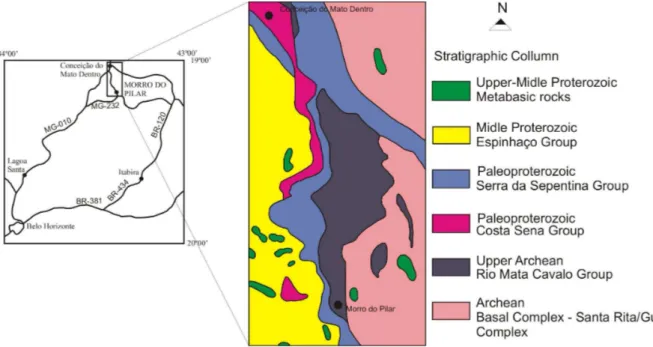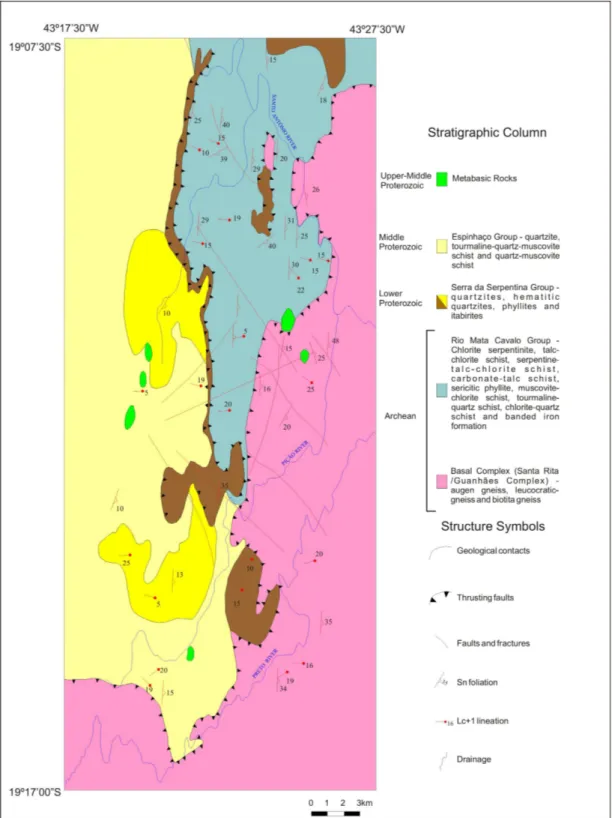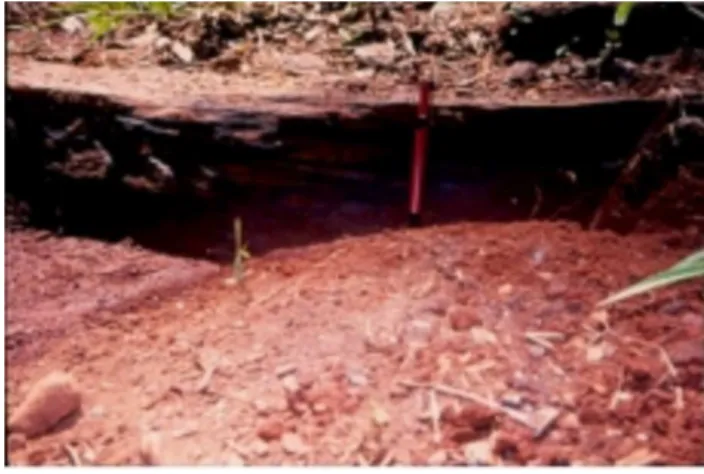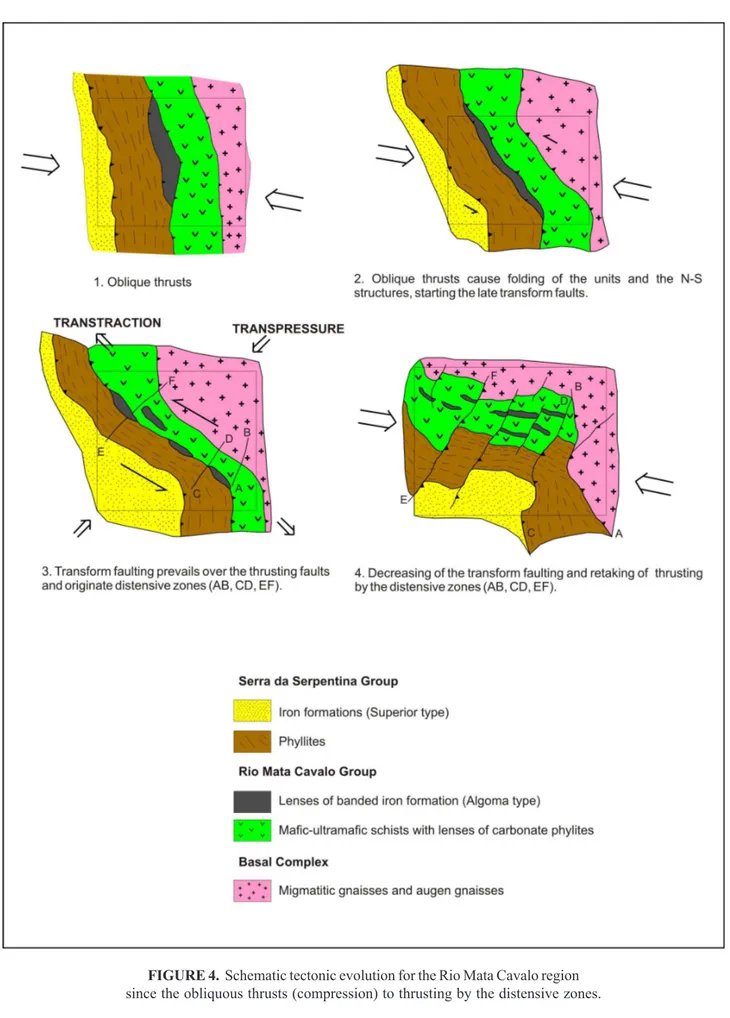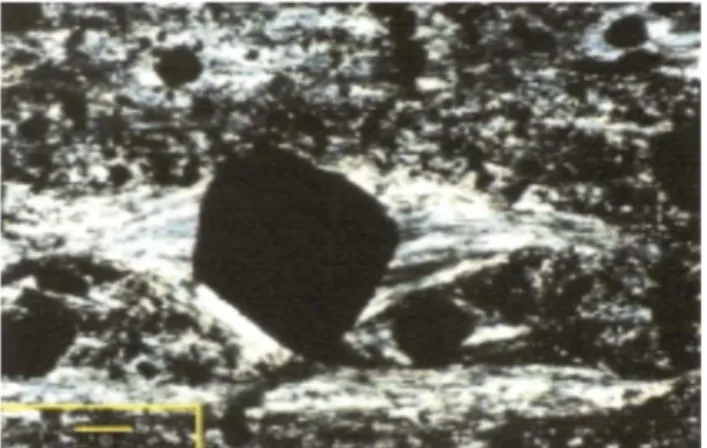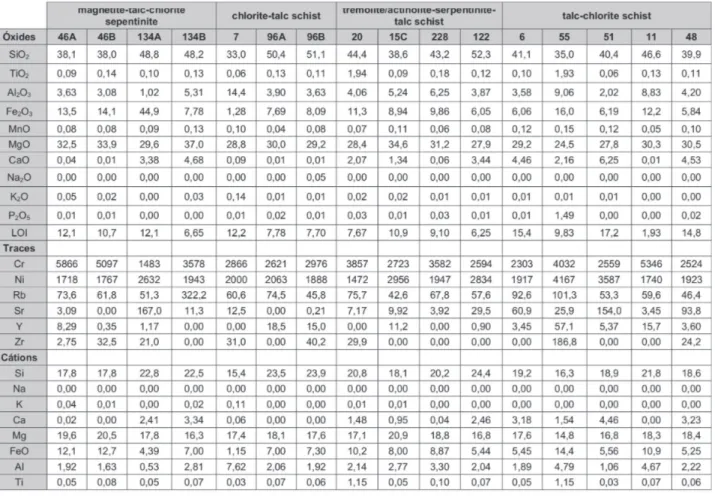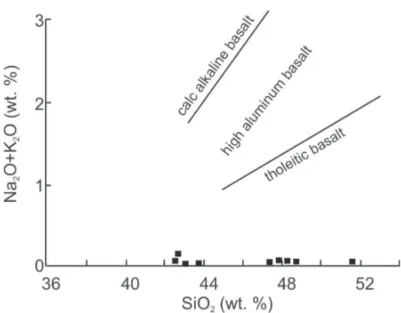THE RIO MATA CAVALO GROUP:
THE GOLD MINERALIZATION AND ITS ORIGIN
THE RIO MATA CAVALO GROUP:
THE GOLD MINERALIZATION AND ITS ORIGIN
Nelson ANGELI 1, Ulisses Cyrino PENHA 2,
Luiz Guilherme KNAUER 3, Gabriel Mineo ITO 1
(1) Department of Petrology and Metallogeny, University of State of São Paulo, Campus de Rio Claro.
Avenida 24-A, 1515 – Bela Vista. CEP 13506-900. Rio Claro, SP. E-mail: nangeli@rc.unesp.br; gabrielm_ito@hotmail.com (2) AngloGold Ashanti Brasil Mineração Ltda. Av. Enfermeiro José Caldeira Brant, 200 – Boa Vista.
CEP 34000-000. Nova Lima – MG. E-mail: ulisses.penha@gmail.com
(3) Geosciences Institute, Federal University of Minas Gerais. Av. Antônio Carlos, 6.627 – Pampulha. CEP 31270-901. Belo Horizonte – MG. E-mail: gkanuer@gmail.com
Introduction Methodology
Geological and Stratigraphic Settings The Mineralization Process Conclusions
Acknowledgements Bibliographic References
ABSTRACT – The metavolcano-sedimentary sequences, at the southeastern of Espinhaço ridge, present difficulties for distinction of Rio das Velhas Supergroup, till now. Besides of very similarities it is possible to separate the Rio Mata Cavalo Group from the last one. It is constituted by metamafic-ultramafic unit derivated from tholeitic basalts, and a chemical-clastic cover. These sediments present gold and Platinum Group Minerals/Elements associated mainly with Banded Iron Formations. Hydrothermal origin is attributed to noble metals concentration. The prospecting and mineral exploration was done only for gold in the study area. The obtained results permit to suggest the use for an Upper Unit, composed by chemical-clastic sediments, and a Lower Unit, which comprises the volcanic rocks as belonging to Mata Cavalo Group. So, this Group presents in Upper Unit magnetite-rich BIF with gold associated to supergene enrichment.
Keywords: metavolcano-sedimentary sequence, gold mineralization, hydrothermalism, Rio Mata Cavalo Group, southeastern of Espinhaço Ridge.
RESUMO –N. Angeli, U.C. Penha, L.G. Knauer, G.M. Ito – O Grupo Rio Mata Cavalo: a mineralização de ouro e sua origem. As sequências metavulcano-sedimentares na serra do Espinhaço Meridional apresentam dificuldades para separação, principalmente do Supergrupo Rio das Velhas, até o presente. Apesar da grande similaridade, é possível distingui-lo do Grupo Rio Mata Cavalo. Esta é constituída por uma unidade metamáfica-ultramáfica derivada de basaltos toleíticos, e uma sequência de cobertura clasto-química, além de apresentar mineralizações de ouro e Minerais/Elementos do Grupo da Platina associados, principalmente a Formações Ferríferas Bandadas. Origem hidrotermal é atribuída à concentração destes metais nobres. Campanhas de prospecção e pesquisa mineral, na área estudada, foram realizadas para ouro. Os resultados até o presente permitem sugerir o emprego de uma Unidade Superior composta pelos sedimentos clasto-químicos e uma Unidade Inferior, que compreende as rochas vulcânicas, ambas compondo o Grupo Mata Cavalo. Desta forma, este Grupo apresenta em sua Unidade Superior rica em níveis de BIF compostas principalmente por magnetita com concentrações de ouro associadas a enriquecimento supérgeno.
Palavras-chave: sequência metavulcano-sedimentar, mineralização de ouro, hidrotermalismo, Grupo Rio Mata Cavalo, Serra do Espinhaço. Meridional.
INTRODUCTION
The volcano-sedimentary Sequence of Rio Mata Cavalo Group, as proposed by Angeli et al. (2008) occurs between Morro do Pilar and Conceição do Mato Dentro towns at the southeastern portion of Espinhaço Ridge, Minas Gerais, Brazil. The study area is located near the contact between the Araçuaí Fold Belt (southwest portion) and the São Francisco Craton. It presents a metasedimentary sequence composed by
sediments at Lower Proterozoic. One of them is an origin of the metavolcano-sedimentary sequence as a greenstone belt (GSB) - (Uhlein & Dardene, 1984) and
the other as Alpine complex (Schorscher et al., 1982). The basement rocks correspond to Archean gneisses and migmatites (Guanhães/Dona Rita Complex).
FIGURE 1. Simplified geological map of the study area and its location at the Minas Gerais state.
METHODOLOGY
Chemical analysis was carried out for sixteen samples, which comprises seventeen elements by X-Ray Fluorescence. The samples were collected at the northeast of Morro do Pilar, due to the well preserved structure and texture of the outcrops. It was utilized the Sequential PW2400 Spectrometer Philips in the LABOGEO (Geochemical Laboratory) at the Department of Petrology and Metallogeny (UNESP, Rio Claro).
A vertical sampling (chip samples) of the serpentinite was studied using seven samples of fresh rocks from the outcrops, between Morro do Pilar and
Conceição do Mato Dentro towns. The samples were studied by petrographical analysis (thin and polished sections), and some selected samples of chromite crystals were analyzed by electron probe microanalyses. These minerals were studied by Scanning Electron Microscopy (LEO 430i – Cambridge/Leika) with EDS (CatB – Oxford Microanalysis Group), and Electron Microprobe analysis (JEOL, Superprobe JXA 8600), with15 kV of acceleration and current of 10A was executed for selected samples with noble metals. These analyses were made in the Department of Geology of the University of Western Ontario (London, Canada).
GEOLOGICAL AND STRATIGRAPHIC SETTINGS
The stratigraphic unities present contacts by thrust faults to N-S direction to São Francisco Craton (transport from E-W). These units are composed by: Basal Complex (Guanhães/Dona Rita Complex), represented by orthogneisses and migmatites and tonalite-granodiorites intrusions. It is characterized by: milonitic gneisses with intercalations of quartzites, mica schists and highly milonitized metasediments (Figure 2). The paragenesis of these complexes is compatible
this is composed by metaultramafic and mafic-ultramafic schists with magnetite and sulfides dissemination, quartzites (Photo 1), carbonaceous phyllites and banded iron formations (Photo 2). Quartz veins cut this unit and present a gold mineralization and some Platinum Group Minerals (PGM) and Platinum Group Elements + Au (PGE+Au). The upper unit (sedimentary cover) comprises phyllites, metasiltites and itabirites belonging
to Serra da Serpentina Group (Dossin, 1985). The itabirites were considered as a Lake Superior type (Uhlein, 1982), and they are not similar to BIF of the Rio Mata Cavalo, which iron is though to be of the Algoma type, a typical archean to paleoproterozoic iron ore. A high content of iron is present in itabirites on top of the metasedimentary unit. They also have low magnetite content with hematite predominance.
PHOTO 1. Upper formation composed by quartzites and phylittes (clastic sediments).
PHOTO 2. Upper formation composed by banded iron formation (chemical sediments).
The tectonic settings of the Mata Cavalo region have a context of local strike-slip faults N80E inside the regional system of thrusting faults N-S very common in the Espinhaço Ridge. The structures were more detailed by geophysics features like radiometric and magnetic anomalies (Figure 3). This settings is the result of a frontal tectonic thrusting with a slight oblique component which have conducted the
FIGURE 3. Structures of Mata Cavalo region interpreted from magnetic and radiometric data showing four different patterns and the main lineaments (modified from: Machado & Penha, 1997).
The metaultramafic rocks were studied with more details. They are composed by serpentinites, tremolite-actinolite-serpentine schists, serpentine-talc schists and Mg-chlorite schists. Serpentinized olivine and enstatite (bastite) were preserved in the same outcrops (Photomicrograph 1), but the mesh texture is frequent, as well as the bladed mat type (Neves, 1988). The sequence frequently presents chromites, magnetites and ilmenites as accessory minerals (Photomicrograph 2). Locally crystals of chromite presents pressure shadows as the result of the shearing deformation (Photomicrography 3). Minor sulfides minerals are pyrite, chalcopyrite pyrrhotite and pentlandite. In the BIF, mainly in the weathered cover, a small quantity of gold was found as micrometric to millimetric nuggets. Machado & Penha (1997) have been carried radiometric and
magnetometric surveys and they concluded that no potential targets have been revealed.
The disseminated chromites in the serpentinites exhibit a hydrothermal alteration, which is observed in polished sections by zoning of the crystals (Angeli & De Carvalho, 1996). Thirty analyses were carried out and the results showed a trend of hydrothermal alteration, which reaches between from the aluminum-chromites to chromium-magnetites (Figure 5). The interaction with the fluids was high at the border of the crystals, and their outer rim were transformed in magnetites. The Mg and Ti also exhibit the same behaviour which indicates the loss of these elements from the core to the rim of the crystals (Morro do Pilar town).
PHOTOMICROGRAPHY 1. Metaperidotite with reliquiary olivine crystals and matrix composed by talc, carbonates
and magnetite. (Crossed nicols) – (Neves, 1998).
FIGURE 5. Ternary diagram showing the alteration due the hidrothermalism on accessory chromites in the serpentinites of the Rio Mata Cavalo Group. Note: the
arrow indicates the alteration trend of the crystals.
PHOTOMICROGRAPHY 3. Metaperidotite showing crystal of chromite with pressure shadows.
(Crossed nicols, LT, 10x zoom).
PHOTOMICROGRAPHY 2. Talc schist: A-Intersticial quartz grain; B-Magnetite grains.
It is quite similar to the observed alteration in chromitite deposits at Alvorada de Minas (Angeli & Vlach, 2004). Chemical analyses for the bulk sample in the metaperidotites and metapyroxenites shows a composition from original tholeiitic magma (see Table 1 and Figure 6). The origin of this unit is derived from peridotitic basalt with high MgO (20-23%), low CaO (6%) and Al2O3 values. Additionally, TiO2 (0.25%) and REE (Σ REE=0.107)CN were observed, corroborating to the tholeiitic origin.
Some outcrops were found as small tectonic fragments elongated in NNW-SSE, and correspond to Pedro Pereira Group (Fogaça et al., 1984), is quite different and represents ancient fragments of a greenstone belt. It is a restrict portion, which occurs in the central part of the Espinhaço ridge (Juscelino Kubtischek Sheet) associated to metaquartizites of the Espinhaço Superior Group. The geometric arrangement of the unities suggests a Mafic-Ultramafic Unity superposed by a Volcanosedimentary Unity, where the last one is represented by itabirites, sericite-quartz schists and rares basic metavolcanic intercalations. The most part
of the outcrops show tectonic contacts with the basement rocks of Gouveia Complex. The ultramafic rocks are well mylonitized, without primary textures or structures, and the mafic domain is predominant. These authors confirm to the Costa Pereira Group, an age older than 2.97 Ga and the possibility which represent a fragments of greenstone belt. It is possible, but there was no relationship with Serro or Rio Mata Cavalo Groups.
At the Rio Mata Cavalo Group the data of Neves (1998) in other diagrams plot in different fields, because strong metamorphic alteration has occurred in some samples. So the rocks belong, sometimes to the group of the extrusive ultramafic rocks (komatiites) from Quebra Osso GSB, to the magnesium-rich tholeiitic basalt class and or in peridotitic group, as a function of no careful sampling (Figure 6). The rocks of Group Pereira Group (Fogaça et al., 1984) certainly represent a greenstone belt sequence with archean age (2.9 ± 16 Ga, U/Pb in zircons by Machado et al. (1989). But this is quite different, and it shows a thrusting, presenting a tectonic contact with basement rocks of Gouveia Complex as tectonic slices.
FIGURE 6. Discrimination diagram for basalts (Viljoen & Viljoen, 1969). The plotted points represent the content from samples of metamafic-ultramafic rocks found in the study area. (Modified from: Neves, 1998).
THE MINERALIZATION PROCESS
Unless the gold occurrences of the study area have no economic significance, its presence is expected due to tectonic position in the collisional belt (Figure 4) associated with hydrothermal events: silicification, carbonatation, sulfidization and turmalinization. The gold mineralization is observed by gossans associated to sulfides-bearing quartz veins. It must be epigenetic ore associated to hydrothermalism, like the metamafic-ultramafic sequence and the crystals of chromite. This mechanism is interpreted for the areas near Morro do Pilar town (Bueiro and Bom-Javá tarjets), despite of no economic concentration of gold were found. So, the epigenetic genesis of gold occurrences is associated to shear zone, where the hydrothermalism developed an important role. The composition of the fluids had low S2 fugacity and few sulfides was crystallized. Associated to these analysis the content in Cu (60 ppm) and Co (100 ppm) are anomalous in the metagraywackes.
Besides gold, PGE-alloys were found (e.g. Pt-Ir). At the Alvorada de Minas town, Angeli & Vlach (2004) found them, in the same conditions, several crystals of PGM (e.g. sperrylite, laurite, irarsite) in the chromitites. The micrometric size and the small concentration indicate a high O2 content in the hydrothermal reactions. The presence of tourmalinites and tourmaline-quartz-muscovite schists associated to tremolitites at the south of Morro do Pilar and near Conceição do
Mato Dentro indicate the kind of the fluid, which has low reaction for sulfide formation (high aO2). Gold concentration occurs mainly in the weathering cover (Photo 3). The prospection and mineral exploration results from the itabirites at the Serra da Serpentina Group resulted with no interesting targets. The main objective was a panning concentrates in the itabirites, and in the contacts of schists to carbonate itabirites (Grossi Sad, verbal information, 2008). Finally, in the gold concentration associated to gossans, were found, near Bom Javá target, 0.04 to 0.20 g/t (Photos 3 and 4), together of goethite and minor pirolusite crystals. The high content is related to bladed nuggets generally with dimensions of 0.2 mm, but the occurrence of them is not frequent than irregular forms of the crystals (0.01 to 0.03 mm). Native silver occurs as traces.
PHOTO 3. Weathering alteration on BIF at the north portion of Morro do Pilar town.
PHOTO 4. Gold concentrates from the gossans with 0.14g/t of gold (laminar and irregular native gold).
CONCLUSIONS
The Rio Mata Cavalo Sequence, till the present time, allows propose the use of Group for these geological units. It is possible to individualize two stratigraphic units in the field and in the geological maps. Finally, the Rio Mata Cavalo Group has a Lower Proterozoic/Upper Archean age, like the Serro Group, despite the stratigraphic columns are distincts. The itabirites near Conceição do Mato Dentro has a relationship with the Minas Supergroup, and it is not similar to the BIF found at Rio Mata Cavalo Group.
This unit presents high-magnetite content No structures or textures were found in the metaultramafic unit, which would characterize a greenstone belt sequence and the same can be observed for the hypothesis of an ophiolitic complex (the geological and geochemical data not shows a fragment of ocean crust in the study area). Unfortunately, the gold concentration is higher in the lateritic cover (ferricretes) than in the unaltered rocks, and the content is very low. This indicates the increasing gold grade due to supergene alteration on BIF.
ACKNOWLEDGEMENTS
The authors are grateful to Dr. João Henrique Grossi Sad for your suggestions and comments, which will be helpful for the enrichment of this paper.
BIBLIOGRAPHIC REFERENCES
1. ANGELI, N. & CARVALHO, S.G. DE. Composição química de cromita em corpos metamáficos/ultramáficos da borda leste do Espinhaço Meridional, Minas Gerais. Geonomos, v. 4, n. 1, p. 11-20, 1996.
2. ANGELI, N.; PENHA, U.C.; KNAUER, L.G.; MOTTA,
J.G.; FONSECA, C.R.A. The Rio Mata Cavalo Metavolcano-sedimentary Sequence: the gold mineralization and its origin.
In: SIMPÓSIO DE VULCANISMO E AMBIENTES ASSOCIADOS, 4, 2008, Foz do Iguaçu. Resumos Expandidos... Foz do Iguaçu: Sociedade Brasileira de Geologia, p. 38-42, 2008.
3. ANGELI, N & VLACH, S.R. Chromite Composition,
CONGRESS OF APPLIED MINERALOGY, 2004, São Paulo. São Paulo: International Mineralogical Association, ICAM - BR Publishing, 2004, v. 2, p. 849-852.
4. DOSSIN, T.M. Geologia e geoquímica das formações
ferríferas da Serra da Serpentina, Conceição do Mato Dentro. Brasília, 1985. 140 p. Dissertação (Mestrado) – Instituto de Geociências, Universidade de Brasília.
5. FOGAÇA, A.C.C.; ALMEIDA ABREU, P.A.;
SCHORSCHER, H.D. Estratigrafia da sequência supracrustal arqueana na porção mediana central da serra do Espinhaço, MG. In: CONGRESSO BRASILEIRO DE GEOLOGIA, 33, 1984, Rio de Janeiro. Anais... Rio de Janeiro: Sociedade Brasileira de Geologia, v. 6, p. 2652-2667, 1984.
6. KNAUER, L.G. Serra do Espinhaço Meridional:
Considerações sobre a estratigrafia e a análise da deformação das unidades proterozóicas. Rio Claro, 1999. 262 p. Tese (Doutorado) – Instituto de Geociências e Ciências Exatas, Universidade Estadual Paulista.
7. NEVES, M.P. Geologia, Petrografia e Geoquímica da
seqüência vulcano-sedimentar Rio Mata Cavalo na região de Morro do Pilar – Borda Leste da Serra do Espinhaço Meridional (MG). Rio Claro, 1998. 148 p. Dissertação (Mestrado em Geociências - Geologia Regional) – Instituto de Geociências e Ciências Exatas, Universidade Estadual Paulista.
8. MACHADO, S.A.M. & PENHA, U.C. Estruturação da
seqüência vulcano-sedimentar Rio Mata Cavalo (Morro do Pilar, MG, Brasil) baseada na análise qualitativa de dados geofísicos. Revista Brasileira de Geofísica, v. 15, n. 2, p. 145-152, 1997.
9. MACHADO, N.; SCHRANK, A.; ABREU, F.R.; KNAUER,
L.G.; ALMEIDA ABREU, P.A.A. Resultados preliminares da geocronologia U/Pb na serra do Espinhaço Meridional. In: SIMPÓSIO DE GEOLOGIA DE MINAS GERAIS, 2, 1983, Belo Horizonte. Anais... Belo Horizonte: Sociedade Brasileira de Geologia, Boletim v. 3, p. 171-174, 1983. 10. PENHA, U.C. & MACHADO, S.A.M. Alvo Bom-Javá: um
exemplo de transcorrências em Morro do Pilar, Espinhaço Meridional/MG. In: SIMPÓSIO DE GEOLOGIA DE MINAS GERAIS, 8, 1995, Diamantina. Anais... Diamantina: Sociedade Brasileira de Geologia, Boletim v. 13, p. 30-31, 1995.
11. SCHORSCHER, H.D.; SANTANA, F.C.; POLONIA, J.C.; MOREIRA, J.M.P. Quadrilátero Ferrífero – Minas Gerais State : Rio das Velhas Greenstone Belt and Proterozoic Rocks. In: INTERNATIONAL SYMPOSIUM ON ARCHEAN AND EARLY PROTEROZOIC GEOLOGICAL EVOLUTION AND METALLOGENESIS, I, 1982, Salvador. Field trip guide... Salvador: Sociedade Brasileira de Geologia, 1982, 46 p.
12. SPEAR, F.S. Metamorphic Phase Equilibria and Pressure-Temperature-Time Paths. Washington: Book Crafters Inc., 2ª ed., 206 p., 1995.
13. UHLEIN, A. & DARDENE, M.A. Estratigrafia e tectônica da região de Serro (MG), borda Leste da Serra do Espinhaço Meridional. In: CONGRESSO BRASILEIRO DE GEOLOGIA, 33, 1984, Rio de Janeiro. Anais... Rio de Janeiro: Sociedade Brasileira de Geologia, v. 5, p. 2289-2301, 1984. 14. VILJOEN, M.J. & VILJOEN, R.P. The geological and
geocheminal significance of the upper formations of the Onverwacht Group. Geological Society of South Africa Special Publication, v. 2, p. 113-151, 1969.
Manuscrito Recebido em: 4 de agosto de 2010
